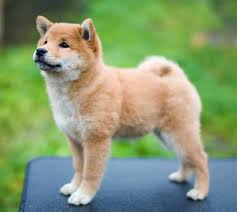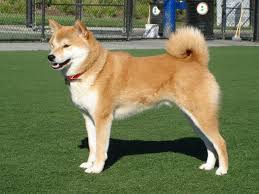Sheba Inu
General
The exact origin of this breed is not known, and it is thought that it originated in Japan around 300B.C , in the mountainous terrain, and would have been used for the hunting of small game, and even wild boar. In general it is a very hardy breed.
In looks, this breed is very similar to the Akita, just smaller in size. It is the smallest of the 6 original spitz breeds from Japan.
The first Shiba dogs entered the United States in the 1950s, and was recognized by the AKC in 1993.
The exact origin of this breed is not known, and it is thought that it originated in Japan around 300B.C , in the mountainous terrain, and would have been used for the hunting of small game, and even wild boar. In general it is a very hardy breed.
In looks, this breed is very similar to the Akita, just smaller in size. It is the smallest of the 6 original spitz breeds from Japan.
The first Shiba dogs entered the United States in the 1950s, and was recognized by the AKC in 1993.
Is this the right dog for you?
This breed does best with a more experienced owner as due to what it was bred for it does tend to try to be domineering and wants its own way. Best training methods are positive reinforcement and rather than one long session, do smaller sessions during the day, which seems to work best for this breed.
Some of the breed tend to be barkers, so teaching the Bark & Shush as a pup can go a long way to preventing excessive barking.
This breed also tends to be shy with strangers, so socializing as a pup is essential, and on going socializing will help to keep the social skills in place. The Sheba is also territorial, and makes a good watchdog.
It is a working dog, so a quick walk around the block is just not going to be enough for this dog. Dogs that do not receive the physical and mental stimulation they need tend to become bored and frustrated, resulting in various behaviour concerns such as excessive barking, digging and chewing.
hardy breed is always on the look out for adventure and may tend to be domineering and headstrong. It is fairly vocal and some even bark a lot. It is alert, shy with strangers, and territorial and is thus an excellent watchdog. The self-confident Shiba is a bold, headstrong, and independent dog. As long as it is given daily exercise, it is active outdoors and calm indoors. It tends to chase small animals and may be scrappy with unknown dogs of the same sex.
This breed does best with a more experienced owner as due to what it was bred for it does tend to try to be domineering and wants its own way. Best training methods are positive reinforcement and rather than one long session, do smaller sessions during the day, which seems to work best for this breed.
Some of the breed tend to be barkers, so teaching the Bark & Shush as a pup can go a long way to preventing excessive barking.
This breed also tends to be shy with strangers, so socializing as a pup is essential, and on going socializing will help to keep the social skills in place. The Sheba is also territorial, and makes a good watchdog.
It is a working dog, so a quick walk around the block is just not going to be enough for this dog. Dogs that do not receive the physical and mental stimulation they need tend to become bored and frustrated, resulting in various behaviour concerns such as excessive barking, digging and chewing.
hardy breed is always on the look out for adventure and may tend to be domineering and headstrong. It is fairly vocal and some even bark a lot. It is alert, shy with strangers, and territorial and is thus an excellent watchdog. The self-confident Shiba is a bold, headstrong, and independent dog. As long as it is given daily exercise, it is active outdoors and calm indoors. It tends to chase small animals and may be scrappy with unknown dogs of the same sex.

Should you have 2 of the same, or 2 pups together?
On average, if well bred this breed will get on with others of its own breed, but do make sure that the existing dog has been well socialized so that it will accept another dog into the home.
When it comes to which sex get on better, your best bet is one male and one female (both sterilized. Never two females. The vast majority of the time two females will get on well until about 8 - 9 months of age and then fighting for position tends to occur. When males have the odd altercation, it tends to be over quickly, but with females, it just intensifies and often the only solution is for one of the females to be re-homed. This is not just for this breed, but in general. Itw is said that with this breed they can be reactive to same sex dogs, so as a safeguard, if you are going to have two - one of each sex is your best option.
Having two pups from same litter is not a good idea. Most people think that the pups will be happier with a playmate and won’t fight if they are family.Your pup should be at least 5 months old, before you consider bringing in another pup. This allows the pups to grow to their full potential and not become over dependent on one another. The truth of the matter is that your two pups are likely to:
Bond with each other to the exclusion of you
On average, if well bred this breed will get on with others of its own breed, but do make sure that the existing dog has been well socialized so that it will accept another dog into the home.
When it comes to which sex get on better, your best bet is one male and one female (both sterilized. Never two females. The vast majority of the time two females will get on well until about 8 - 9 months of age and then fighting for position tends to occur. When males have the odd altercation, it tends to be over quickly, but with females, it just intensifies and often the only solution is for one of the females to be re-homed. This is not just for this breed, but in general. Itw is said that with this breed they can be reactive to same sex dogs, so as a safeguard, if you are going to have two - one of each sex is your best option.
Having two pups from same litter is not a good idea. Most people think that the pups will be happier with a playmate and won’t fight if they are family.Your pup should be at least 5 months old, before you consider bringing in another pup. This allows the pups to grow to their full potential and not become over dependent on one another. The truth of the matter is that your two pups are likely to:
Bond with each other to the exclusion of you
- Will stress without the other dog being around
- Fight with each other
- Be more destructive and boisterous
- Two pups together often leads to one being more assertive and the other more submissive. This could well end up in a situation where the more submissive dog will never develop its full potential.
- Mature later
Do they get on with other dogs?
Historically, the Shiba was often known to be aggressive towards other dogs, especially of the same sex. However, better breeding has now produced a dog where these tendencies are much improved, however, if provoked or challenged, it will react. As a safeguard, always take you pup to puppy socializing and with this breed, don't just stop there - continue the socialization - this makes for a solid social foundation.
Historically, the Shiba was often known to be aggressive towards other dogs, especially of the same sex. However, better breeding has now produced a dog where these tendencies are much improved, however, if provoked or challenged, it will react. As a safeguard, always take you pup to puppy socializing and with this breed, don't just stop there - continue the socialization - this makes for a solid social foundation.
Do they get on with other animals?
They can do if introduced as a puppy, however this dog is bred to hunt small animals, and may take off after the cat next door, or any other small animals it encounters.
They can do if introduced as a puppy, however this dog is bred to hunt small animals, and may take off after the cat next door, or any other small animals it encounters.
Are they good with children?
Even though this dog can be a bit otherwise at times, it really does make a good family pet and is good and protective towards its family and children in the family. However, all children should be taught how to approach and interact with children, especially with this breed, as if treated roughly it may show its displeasure.
The dog should be socialized with people and children from being a pup and this should be ongoing.
Even though this dog can be a bit otherwise at times, it really does make a good family pet and is good and protective towards its family and children in the family. However, all children should be taught how to approach and interact with children, especially with this breed, as if treated roughly it may show its displeasure.
The dog should be socialized with people and children from being a pup and this should be ongoing.
Health
Overall, this is a very hardly little dog, and when health problems are experienced, considtions such as allergies, cataracts, patellar luxation, HD, and PRA are what may occur.
“In today’s age, with the rising cost of veterinary care, it really is a wise decision to consider medical insurance for your pets. Depending on the plan you choose, you can ensure that if your pet does develop one of the health issues the breed is prone too, that you will be covered –additionally, just knowing that any accident your pet may have will be covered, will out-weigh the monthly insurance fee for most pet owners. Our own personal choice is Genricpet as they have a ‘no limit’ policy and their rates are comparable to the rest of the industry. To find out the questions and things to look for in a Medical Insurance, please just follow this link”
Overall, this is a very hardly little dog, and when health problems are experienced, considtions such as allergies, cataracts, patellar luxation, HD, and PRA are what may occur.
“In today’s age, with the rising cost of veterinary care, it really is a wise decision to consider medical insurance for your pets. Depending on the plan you choose, you can ensure that if your pet does develop one of the health issues the breed is prone too, that you will be covered –additionally, just knowing that any accident your pet may have will be covered, will out-weigh the monthly insurance fee for most pet owners. Our own personal choice is Genricpet as they have a ‘no limit’ policy and their rates are comparable to the rest of the industry. To find out the questions and things to look for in a Medical Insurance, please just follow this link”
Do’s and Dont’s
Do’s
Don’t
Do’s
- Do get your pup from a KUSA registered breeder and do read the articles on Breeders and also choosing a pup
- Sterilize at approximately 6 months of age.
- Do take your pup for socialization - pups should start at 8 weeks of age and this should not be missed - lays the foundation for future social interactions.
- Do continue the socialiazation - keeps solid social skills in place
- Give daily, regular exercise which this breed really needs.
- Supply chew toys and mental stimulation when left alone.
- Allow your dog to be part of the family
- Give regular brushing and annual vacs.
- Supply mental games such as behaviour games, scenting games etc in the garden to mentally stimulate this breed.
- Take your dog for basic training and keep simple house rules in place
Don’t
- Don't use aversive training methods.
- Leave this breed outside alone – behaviour problems will develop


